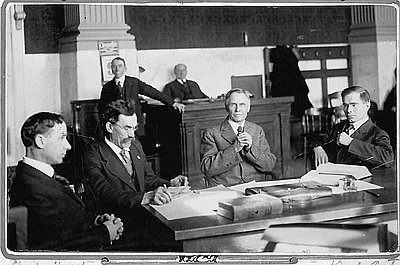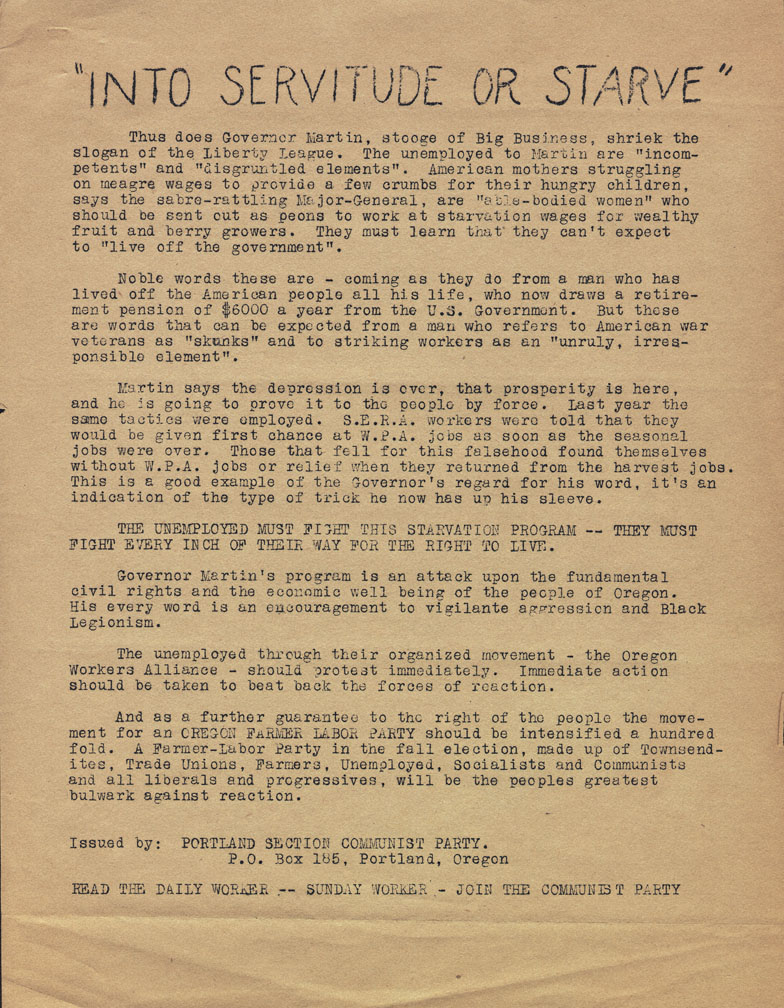- Catalog No. —
- Mss 1505-1
- Date —
- 1937
- Era —
- 1921-1949 (Great Depression and World War II)
- Themes —
- Government, Law, and Politics, Labor, Trade, Business, Industry, and the Economy
- Credits —
- Oregon Historical Society
- Regions —
- Portland Metropolitan
- Author —
- Portland Section Communist Party
Into Servitude or Starve
The Portland Communist Party produced this flier to protest Governor Charles H. Martin’s anti-labor policies and to rally political support for an Oregon Farmer-Labor Party. The Communist Party had been active in the Pacific Northwest since 1919, when socialists and labor activists were inspired by the Russian Bolshevik Revolution. The party published a national newspaper called the Daily Worker.
Martin, a conservative Democrat, was a virulent anti-Communist who served as Oregon’s governor from 1935 to 1939. In a 1935 letter to former Oregon Governor Walter E. Pearson, Martin referred to Oregon union leaders and activists as “pestiferous peewees” who would “go to any lengths to embarrass me and my administration.” Shortly after that, Martin called for a law-enforcement crackdown on striking timber workers. As the Great Depression swept across the United States, activists staged rallies to demand government assistance, jobs, and better wages. People also joined the Townsendites in their quest for an old-age pension. President Franklin D. Roosevelt responded with the New Deal, a variety of programs that created jobs and provided social welfare for the American public. Not everyone supported Roosevelt’s actions. In 1934, conservative Democrats formed the national Liberty League. Like Gov. Martin, members of the Liberty League opposed New Deal programs. Martin’s anti-labor stance and his opposition to federal unemployment relief programs, such as the Works Progress Administration (WPA) and the State Emergency Relief Administration (SERA), made him the target of numerous demonstrations.
The Farmer-Labor Party failed to unite Oregon’s farmers and union members, and the movement died in the late 1930s. During that time, Oregon’s labor unions attempted to distance themselves from the Communist Party, which remained strong into the early 1940s.
Further Reading:
Murrell, Gary. “Hunting Reds in Oregon, 1936-1939.” Oregon Historical Quarterly 100, 1999: 374- 401.
Cherny, Robert W. “The Making of a Labor Radical: Harry Bridges, 1901-1934.” Pacific Historical Review 64, 1995: 363-388.
Lovin, Hugh T. “Toward a Farmer-Labor Party in Oregon, 1933-38.” Oregon Historical Quarterly 76, 1975: 135-151.
Written by Kathy Tucker, © Oregon Historical Society, 2002.
Related Historical Records
-
Labor Unrest between the Wars
By the end of the 1920s, conditions for workers had improved from those of the days before World War I. The eight-hour day had been almost universally adopted, …
-
U'Ren Defends Communist Labor Party Members
This March 10, 1920, photograph shows Oregon lawyer William S. U’Ren defending members of the Portland Communist Labor Party against charges of violating the state criminal syndicalism law. U’Ren, who …

-
Labor Struggles
The most significant influence of World War I on the Pacific Northwest is reflected in the changing course of labor relations. Shortly after the United States joined the …
